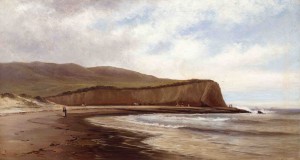
“The Permanent Collection: A Fresh Look,” “ex.pose: Macha Suzuki” and “Timothy J. Clark” exhibitions that opened earlier this month evidence the Laguna Art Museum’s willingness and ability to simultaneously embrace the past, present and future.
The Permanent Collection, an exhibition curated by the museum’s executive director, Malcolm Warner, offers a jaunt through California art history minus yawn-inducing didactics. Exploration begins with some of the oldest works like “Giant Sequoia,” from 1900 and ends in the late 1960s, decades that are well represented by examples from the Light and Space, Finnish Fetish and pre-Pop Art movements. Viewers can also pass through Laguna’s historic heyday captured by Joseph Kleitsch’s “Old Post Office,” 1922, Frank Cuprien’s still glorious “Golden Hour,” 1923 or Roger Kuntz’s “Beach Culvert,” 1960.
Warner says that he may not have looked through every one of the roughly 3,500 pieces currently comprising the museum’s permanent collection, but his choices from what he describes as everything by artists on the top 100 list, suggest that looking at art should be educational and fun, with a few head-scratchers like Robert Arneson’s 1963 creation titled “The Pisser.” It may be unabashedly ugly, but its irreverent reference to Marcel Duchamp’s iconic urinal wins the day.
Warner’s choice of three large John Altoon paintings reveals an interest in stylistic transitions. Altoon’s work veers off into pure abstraction to explore marks and symbols (Untitled, 1962) and fills a canvas with playful whitish squiggles (“P-3 From the Sunset Series)” 1965. “Many painters in the ‘60s were interested in exploring dimensions or illusion of dimension by becoming playful,” Warner said. “The Altoons rank among the most important pieces we have,” he said.
Viewers with a wide variety of preferences get to pick their own highlights since works run a stylistic gamut from Mabel Alvarez’s “In the Garden” to Hans Gustav Burkhardt’s “Card Players,” 1956 to Karl Benjamin’s “Abstraction,” 1955.
Warner cites Helen Lundeberg’s 1973 “Aegian Light,” as a personal favorite. “That painting is close to our hearts since we are planning a Lundeberg exhibition in 2015,” he said.
As often is the case, the unclassifiable, featuring human likenesses like Fletcher Martin’s 1938 “Lad from the Fleet” or Francis De Erdely’s 1945 “The Drummer,” tend to stick in one’s mind. “Day’s End,” also by De Erdely in 1947, is timeless in its portrayal of hope embodied by an impoverished young couple and their infant.
Mastery of medium rather than stylistic diversity classifies watercolor paintings by Timothy J. Clark. “Artist on the Hill,” is a textbook example of fine composition with the subject and background in perfect rhythmic sync. A painting of a bicycle resembles a portrait rather than a mere rendition of an inanimate object. “The Water Carriers,” adds a touch of exotica.
In the museum’s basement galleries, viewers first encounter “Minor Threat,” 2008, by Macha Suzuki, a sheep pierced by an arrow and surrounded by at least 20 more deployed for the same purpose. This four-legged “St. Sebastian” can be interpreted as representation of stoic forbearance in face of the inevitable. And, animal rights activists take note, the sheep has been created from chicken wire and wrapping with its snowy fur made from small pompons, said Grace Kook-Anderson, the show’s curator.
Suzuki is the discovery of Kook-Anderson, who has staged another “ex.pose” exhibition to spotlight work by young and underrepresented artists and one that also fully engages viewers visually, intellectually and emotionally.
Born in 1979, the Japanese-born artist takes his recent fatherhood as a stepping off point to explore transitions from young man to adult and the implications and meaning of “failure.” Not prone to negativity, Suzuki celebrates failure as a useful by-product of creativity. “Permission to Fail,” a relief sculpture of a tree with the word “Fail” embroidered into its branches, speaks of how people’s fear of failure causes them to settle for less than the ideal. “Success comes with trying, over and over again,” he said.
While the show is full of standouts, “The Huddle,” an installation of 11 life-sized sculptures of men in black hoodies, their heads obscured by black lantern-like masks arranged in a circle, deserves to be called awesome. The piece references football, but Suzuki also calls it a cross between a prayer circle and a strategy meeting. “As a new father I have had to leave my group of young guys behind to become an adult,” he said. To achieve the sculptures’ life-like effect, Suzuki posed and made casts of himself by wrapping himself in plastic and yards of duct tape, explained Kook-Anderson.
“In the art world, especially among young grad students there have been discussion of the meaning of failure, but without a lengthy sense of time yet young artists dismiss such concerns in favor of social conscience,” she said.
Like the trio of exhibits, Suzuki seems to have feet in both the past and present.





[…] Pilot . >> ArtDaily.org . >> Art Ltd. Magazine . >> COAST Magazine . >> Laguna Beach Independent Filed Under: Museum […]